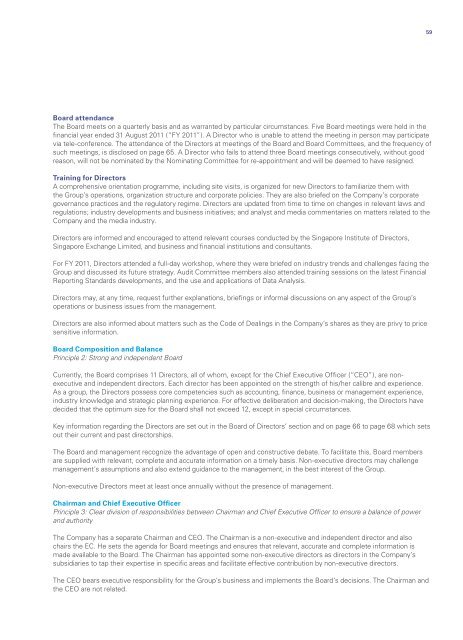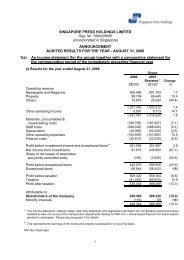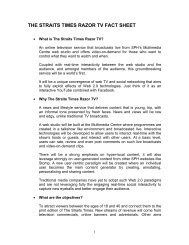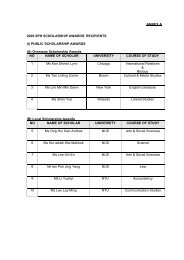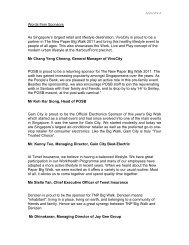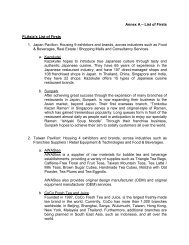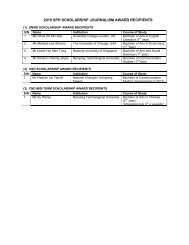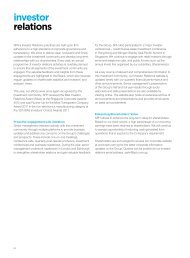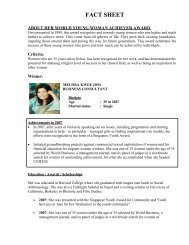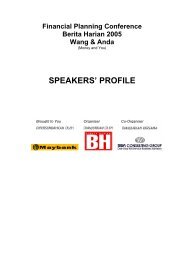Singapore Press Holdings annual report 2011 Singapore Press ...
Singapore Press Holdings annual report 2011 Singapore Press ...
Singapore Press Holdings annual report 2011 Singapore Press ...
You also want an ePaper? Increase the reach of your titles
YUMPU automatically turns print PDFs into web optimized ePapers that Google loves.
59<br />
Board attendance<br />
The Board meets on a quarterly basis and as warranted by particular circumstances. Five Board meetings were held in the<br />
financial year ended 31 August <strong>2011</strong> (“FY <strong>2011</strong>”). A Director who is unable to attend the meeting in person may participate<br />
via tele-conference. The attendance of the Directors at meetings of the Board and Board Committees, and the frequency of<br />
such meetings, is disclosed on page 65. A Director who fails to attend three Board meetings consecutively, without good<br />
reason, will not be nominated by the Nominating Committee for re-appointment and will be deemed to have resigned.<br />
Training for Directors<br />
A comprehensive orientation programme, including site visits, is organized for new Directors to familiarize them with<br />
the Group’s operations, organization structure and corporate policies. They are also briefed on the Company’s corporate<br />
governance practices and the regulatory regime. Directors are updated from time to time on changes in relevant laws and<br />
regulations; industry developments and business initiatives; and analyst and media commentaries on matters related to the<br />
Company and the media industry.<br />
Directors are informed and encouraged to attend relevant courses conducted by the <strong>Singapore</strong> Institute of Directors,<br />
<strong>Singapore</strong> Exchange Limited, and business and financial institutions and consultants.<br />
For FY <strong>2011</strong>, Directors attended a full-day workshop, where they were briefed on industry trends and challenges facing the<br />
Group and discussed its future strategy. Audit Committee members also attended training sessions on the latest Financial<br />
Reporting Standards developments, and the use and applications of Data Analysis.<br />
Directors may, at any time, request further explanations, briefings or informal discussions on any aspect of the Group’s<br />
operations or business issues from the management.<br />
Directors are also informed about matters such as the Code of Dealings in the Company’s shares as they are privy to price<br />
sensitive information.<br />
Board Composition and Balance<br />
Principle 2: Strong and independent Board<br />
Currently, the Board comprises 11 Directors, all of whom, except for the Chief Executive Officer (“CEO”), are nonexecutive<br />
and independent directors. Each director has been appointed on the strength of his/her calibre and experience.<br />
As a group, the Directors possess core competencies such as accounting, finance, business or management experience,<br />
industry knowledge and strategic planning experience. For effective deliberation and decision-making, the Directors have<br />
decided that the optimum size for the Board shall not exceed 12, except in special circumstances.<br />
Key information regarding the Directors are set out in the Board of Directors’ section and on page 66 to page 68 which sets<br />
out their current and past directorships.<br />
The Board and management recognize the advantage of open and constructive debate. To facilitate this, Board members<br />
are supplied with relevant, complete and accurate information on a timely basis. Non-executive directors may challenge<br />
management’s assumptions and also extend guidance to the management, in the best interest of the Group.<br />
Non-executive Directors meet at least once <strong>annual</strong>ly without the presence of management.<br />
Chairman and Chief Executive Officer<br />
Principle 3: Clear division of responsibilities between Chairman and Chief Executive Officer to ensure a balance of power<br />
and authority<br />
The Company has a separate Chairman and CEO. The Chairman is a non-executive and independent director and also<br />
chairs the EC. He sets the agenda for Board meetings and ensures that relevant, accurate and complete information is<br />
made available to the Board. The Chairman has appointed some non-executive directors as directors in the Company’s<br />
subsidiaries to tap their expertise in specific areas and facilitate effective contribution by non-executive directors.<br />
The CEO bears executive responsibility for the Group’s business and implements the Board’s decisions. The Chairman and<br />
the CEO are not related.


